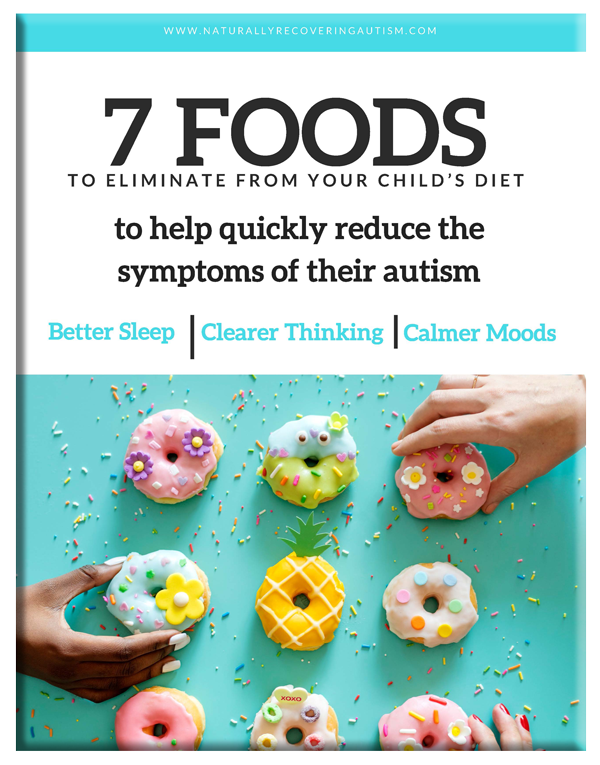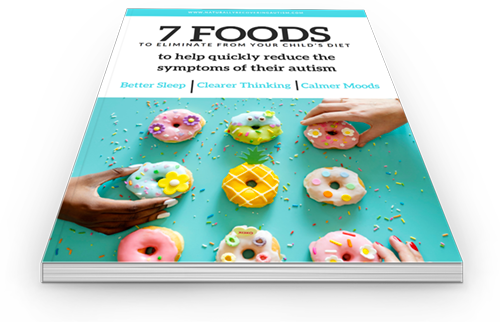Have you ever been told that your child cannot recover from autism? Yea, me too. Yet today, my son is no longer diagnosable with the symptoms of autism he once had.
Sometimes instead of getting excited when they hear this, a parent will get defensive, as though someone is trying to change ‘who’ their child is. Autism is not a ‘who’. It’s a ‘what”.
Do you ever wonder why some parents are able to recover their children from the symptoms of autism while others are struggling with constant illnesses and behaviors that don’t ever seem to improve?
If you’re a parent of a child newly diagnosed with autism, but you aren’t finding the answers you need, or you’re a parent of a child with autism who has been searching for years to find the right solutions to help your child but you are not getting the positive results you hoped for, stay with me because you’re going to discover why persistent parents like you and me can get our children better faster, safer, and with the least amount of expense and why it’s critical that you get all of the right resources in place right now.
My goal is simple: to help you to more easily bring your child to the healthiest outcome possible, whether you’re new to the autism journey or you’ve been on it for years, this episode can help you.
The more you can truly understand and narrow down what it is you need to do and how to do it, the greater opportunity you’ll have to experience your child living a better quality of life.
First, you’ve got to believe that your child can get better, any amount of better. Now you may not have seen any of this in the past, so keep an open mind as we move forward. That’s all I ask, for your child’s sake.
The questions arise, “What causes the symptoms of autism?”
“Is it autism or is there something underlying that is causing symptoms in a child that are mimicking those of autism?”
This may seem like an odd thing to say but there is a lot of truth behind it. Autism can be a symptom, not a diagnosis. It can be a symptom of something underlying such as toxins, pathogens, infections, a compromised immune system, and inflammation in the brain. Many things cause the symptoms of autism. It’s not just one thing.
This information may be completely contradictory to what “experts”, and non-experts, such as friends and relatives have told you before. Have you ever heard that …recovery isn’t possible? I like to say, “Tell that to my son.”
When my own son was diagnosed with autism I was told to drug him and try behavioral therapies but that there was nothing we could do for him otherwise, except manage his symptoms. Knowing life would be difficult for him (and the rest of our family) living with the symptoms of oppositional defiance disorder, OCD, sensory issues that made it difficult to sit in a classroom, constantly getting in trouble, an inability to focus and concentrate when he is brilliant, have difficulty sleeping, connecting with others, making friends, digestive disorders, and debilitating headaches and stomach aches that would wake him up at 3AM screaming, so I began my own research to help him feel better, but I got a lot more!
It took me a decade to figure it out, but today my son is no longer diagnosable with autism. He lives a happy, healthy life free of his once debilitating symptoms. Now I am able to share what I’ve learned with you as I have for other parents worldwide who wish to help their children live to their highest potential.
First, to compare symptoms, let’s look at the Diagnostic criteria for autism as in the DSM.
DSM stands for “Diagnostic and Statistical Manual of Mental Disorders,” which is a manual published by the American Psychiatric Association. The manual includes classifications of psychiatric disorders for use by medical and mental health professionals. Clinicians may refer to versions of the DSM to look for diagnostic codes of different disorders and examine criteria for diagnosis. About 25% of the disorders are specific to children and are in the section of “Disorders Usually First Diagnosed in Infancy, Childhood and Adolescence.” Autism and related disorders have been specifically included in different versions of the DSM since 1980.
The latest edition of the DSM, DSM-5, made significant changes to the diagnostic criteria for autism and related disorders. In DSM-IV, five separate diagnoses were classified under the heading “Pervasive Development Disorders:” Autistic disorder, Asperger Syndrome, Pervasive Development Disorder Not Otherwise Specified (PDD-NOS), Rett Syndrome, and Childhood Disintegrative Disorder. The Pervasive Development Disorder category no longer appears in DSM-5, and Autistic disorder, Asperger Syndrome, and PDD-NOS have now been combined into one label: Autism Spectrum Disorder (ASD).
The criteria in the DSM-5 for diagnosing ASD include 3 listed deficits in social communication and social interactions. Clinicians must be sure that these characteristics are not due to developmental delay alone. To be diagnosed with ASD, an individual must meet all three of the following criteria:
- Difficulties in social emotional reciprocity, including trouble with social approach, back and forth conversation, sharing interests with others, and expressing/understanding emotions.
- Difficulties in nonverbal communication used for social interaction including abnormal eye-contact and body language and difficulty with understanding the use of nonverbal communication like facial expressions or gestures for communication.
- Deficits in developing and maintaining relationships with other people (other than with caregivers), including lack of interest in others, difficulties responding to different social contexts, and difficulties in sharing imaginative play with others.
The criteria in the DSM-5 also include demonstrating at least 2 of the following 4 restricted and repetitive behavior, interests, or activities:
- Stereotyped speech, repetitive motor movements, echolalia (repeating words or phrases, sometimes from television shows or from other people), and repetitive use of objects or abnormal phrases.
- Rigid adherence to routines, ritualized patterns of verbal or nonverbal behaviors, and extreme resistance to change (such as insistence on taking the same route to school, eating the same food because of color or texture, repeating the same questions); the individual may become greatly distressed at small changes in these routines.
- Highly restricted interests with abnormal intensity or focus, such as a strong attachment to unusual objects or obsessions with certain interests, such as train schedules.
- Increased or decreased reactivity to sensory input or unusual interest in sensory aspects of the environment, such as not reacting to pain, strong dislike to specific sounds, excessive touching or smelling objects, or fascination with spinning objects.
Under DSM-5, ASD is now diagnosed by symptoms based on both the current functioning and past functioning of an individual. This new observational criteria will allow clinicians to diagnose people who may have shown some signs early in development, but whose symptoms didn’t become clear until adolescence or adulthood.
In addition to the changes in criteria for the ASD diagnosis, the new DSM-5 has also added a severity rating. The new DSM offers ways to identify ASD levels of severity for each individual. The 3 levels of severity include:
- Level 1. “REQUIRING SUPPORT”: Individuals with this level of severity have difficulty initiating social interactions, may exhibit unusual or unsuccessful responses to social advances made by others, and may seem to have decreased interest in social interactions. Additionally, repetitive behaviors may interfere with daily functioning. These individuals may have some difficulty redirecting from their fixed interests.
- Level 2. “REQUIRING SUBSTANTIAL SUPPORT”: Individuals with this level of severity exhibit marked delays in verbal and non-verbal communication. Individuals have limited interest or ability to initiate social interactions and have difficulty forming social relationships with others, even with support in place. These individuals’ restricted interests and repetitive behaviors are obvious to the casual observer and can interfere with functioning in a variety of contexts. High levels of distress or frustration may occur when interests and/or behaviors are interrupted.
- Level 3. “REQUIRING VERY SUBSTANTIAL SUPPORT”: This level of severity causes individuals with ASD severe impairment in daily functioning. These individuals have very limited initiation of social interaction and minimal response to social overtures by others and may be extremely limited in verbal communication abilities. Preoccupations, fixed rituals, and/or repetitive behaviors greatly interfere with daily functioning and make it difficult to cope with change. It is very difficult to redirect this person from fixated interests.
Does any of this sound familiar to you?
Now, let’s look at some of the symptoms from various toxins, pathogens and co-infections. Many mimic the symptoms of autism.
Parents ask all the time, Karen, why does my child do this (symptom)? The answer varies because any symptom is created by the cause or causes and its effect on the brain. There can be multiple causes and multiple symptoms depending on where the body and the brain are being affected by that toxin or organism and the inflammation they are creating.
LEAKY GUT
Yeast or candida is a living organism that can attach itself to the wall of the intestines, creating holes that allow undigested foods and other toxins to enter the bloodstream. This is known as “leaky gut.”
If any food gets into the bloodstream intact, it can be very toxic to the entire system, especially the brain. This lowers resistance to infections and leaves us vulnerable to greater susceptibility of food intolerance and allergies. This is something we see commonly in children with autism.
Immune reactions of this sort cause the body to be in a continual fight for health. When the immune system is constantly in the “on” position, it can become depleted, leaving us even more vulnerable to infection disease and autoimmune illnesses. It also depletes the body’s levels of the brain messenger serotonin, which contribute to anxiety, depression, and sleep disorders.
CANDIDA
Some examples of illnesses caused by Candida and larger molecules passing through the gut lining are rheumatoid arthritis, asthma, food allergies, celiac disease, skin disorders such as eczema, and pancreatic dysfunction, which reduces the body’s ability to produce enough enzymes needed for digestion of food and for many necessary cellular reactions.
The emotional components are just as bad, if not worse.
Symptoms can include, but are in no way limited to:
- hyperactivity,
- an inability to handle emotions,
- aggressive behavior,
- brain fog,
- poor vision,
- missed sleep,
- constipation,
- diarrhea,
- rashes,
- OCD,
- memory loss,
- poor coordination,
- and extreme fatigue.
Adrenal fatigue erupts from the body working tirelessly, often since birth, to balance the pathogens and toxins which disrupt neurotransmitters, blood sugar, hormones, GI and immune system efficiency. These create negative behaviors and mis-wiring of the brain. An imbalance of adrenal hormones can impair the body’s ability to grow and to recover from illness and injury.
As the suppressed immune system weakens further and the pathogenic bacteria are fed the foods that help them grow, eventually the child begins having physical and emotional symptoms due to the toxins and inflammation invading his blood and neurological system.
There are many foods to remove from the diet to help prevent leaky gut and allow your child’s gut to heal. Get your free guide to the top 7 foods to avoid.
Heavy Metals
Lead
Lead is a heavy metal most commonly found in buildings built in or prior to the 1960s, although lead-based paint was not banned until 1978. It is found both in lead-based paint and the dust in these buildings. Exposure is highest for those who have lived in or visited older structures that have not been properly cleaned up. This includes schools of all kinds that our children spend countless hours in.
Breathing in the dust or getting it on hands that end up in the mouth, even in minute amounts, can cause lead poisoning. It can also enter the body through a cut in the skin, and a piece of lead as small as a grain of salt can poison you.
Lead poisoning can come from:
- The dust from old lead-based paints
- Soil
- Lead plumbing fixtures
- Newsprint
- Ceramic glaze
- Cosmetics
- Imported toys, such as those from China
- Jewelry
The Mayo Clinic states that children under the age of six are especially vulnerable to lead poisoning. Lead crosses the blood-brain barrier and even in small amounts severely affects the brain, kidneys, cardiovascular system, and the reproductive system. Lead easily passes through the placenta from mother to baby, directly affecting brain development. This may cause mental retardation, difficulty with visual-motor coordination, and cognitive learning disabilities that can last a lifetime. Lead is known to be a contributor to ADHD. It also reduces iron and zinc in the body. Iron is needed for the production of the neurotransmitter dopamine.
Lead disrupts normal brain neurotransmitter function of:
- Acetylcholine, affecting memory and motor function
- Dopamine, affecting autonomic motor control in the brain, behavior, and emotions
- Serotonin levels in the brain, which helps to regulate violence, mood, sleep and appetite.
- The GABA system, which we rely on to keep our brain signals calm; when this system is disrupted, we commonly experience anxiety.
Exposure to high levels of lead may cause anemia, weakness, and kidney and brain damage. Very high lead exposure can be fatal. Lead can cross the placenta, which means pregnant women who are exposed to lead also expose their unborn child. Lead can damage a developing baby’s nervous system.
A study by The Center for Disease Control (CDC) in 2017 notes,
“Decrease in lead exposure in early childhood is significantly responsible for the drop in crime rate. Summary: Kids exposed to lead as young children are more likely to be suspended or incarcerated during their school years, suggests a new study.”
Lead can go undetected, showing no obvious symptoms; however, a child with high levels of lead in his system is more likely to fail the third grade due to learning difficulties. The heavy metal toxicity may be overlooked.
Symptoms of lead poisoning include:
- Neurological problems (learning disabilities)
- Depression
- Poor memory
- Problems with social engagement
- Aggressive and even violent behavior
- Gastrointestinal problems
- Constipation
- Diarrhea
- Nausea and/or vomiting
- Poor appetite
- Weight loss
- Insomnia
- Metal taste in the mouth
- Excessive fatigue
- Hyperactivity
- Headaches
- Seizures
- Anemia
- Kidney problems
- Reproductive problems
- Weakness in the muscles of the hand
Mercury
Those at highest risk of mercury toxicity are those with developing brains such as fetuses, infants, and children. Males are also at higher risk because testosterone enhances its neurotoxicity.
Autism affects four times as many boys as girls. Hormones play a part in this. The neurotoxicity of mercury is enhanced by testosterone, which is predominant in boys. Autism is sometimes labeled as an “extreme male brain.” Higher levels of estrogen in females protects the brain, especially the hippocampus. The hippocampus is a part of the brain that helps regulate emotions and memory.
Mercury amalgam fillings release mercury into the body, so a mother can pass it in utero to her child.
Symptoms of mercury toxicity are:
- Excessive irritability/anger
- Timid behavior
- Depression
- Weakness
- Delirium
- Insomnia
- Apathy
- Impaired concentration
- Poor memory
- Abnormal motor coordination
- Suicidal tendencies
- Personality changes
- Obsessive compulsive disorder
Some of the biological effects of mercury:
- Can cause lifelong immune deficiency.
- Causes a loss of glutathione
- Resists removal of the pathogenic yeast Candida albicans
- Inactivates contacted molecules of glutathione two-fold.
- Reduces antioxidant levels
- Disrupts metabolism of creatine, causing poor muscle tone and weakness
- Renders the body defenseless against free radicals
- Interrupts protein synthesis
- Retards brain development by interfering with DNA and RNA function
- Depletes protein-bound sulfhydryl groups and lower the body’s immunity
- Destroys glutamate transport proteins responsible for removing glutamate from neurons causing mis-wiring of the brain (often causing dementia and problems with motor control)
- Destroys enzyme functioning creating faulty wiring of the brain
- Promotes the production of inflammatory cytokines, which are essential in fighting viruses
- Disrupts protein digestion
- Can enter the area of the brain called the hypothalamus, which is responsible for metabolic function, hormonal balance—including neuro-hormones—hunger, thirst, body temperature, and the circadian rhythm affecting the sleep-wake cycle. An injured hypothalamus can cause lifelong suppression of the immune system, and weaken the adrenals and thyroid.
- Can inhibit neurotransmitters (the brain’s messengers) such as serotonin, dopamine, and norepinephrine.
- Increases your body’s lipid peroxidation. This is when the fatty membranes in our body are oxidized by free radical damage. This, first and foremost, affects organs with a high fat content, such as the brain. It weakens the cell membranes and proteins within the cells. When this happens, enzymes are lost and cells cannot function.
- Increases susceptibility to seizures
- Renders the brain vulnerable to damage from excitotoxins
Do any of these symptoms sound familiar?
Aluminum
Aluminum reduces the phospholipids, or fat structure of the myelin, (the carrier of messages to and from the brain). Unfortunately, the brain holds onto aluminum and has a hard time letting go. Once in the brain, it distributes itself, but primarily affects DNA synthesis controlling how the cells function. Aluminum depletes mineral absorption.
Aluminum affects the following neurotransmitters:
- Acetylcholine and the enzyme that breaks down acetylcholine: involved in learning and memory.
- Norepinephrine: involved in attention and focus
- Dopamine: the feel good chemical, also involved in our ability to concentrate and focus
- Serotonin: affects mood, appetite, and sleep
The Co-Infections of Autism
The coinfections of autism are commonly missed. They include mold biotoxins, PANS, Lyme disease, and parasites.
Many of the symptoms of these infections overlap but they cause similar distress and must be treated properly or results on your autism recovery journey will be minimal.
MOLD
TYPICAL SYMPTOMS (due to chronic inflammatory response):
The most common symptoms are neurological, pulmonary, visual, dizziness, and stiffness and or pain in the back of the head and neck although they can vary greatly. This chronic inflammatory response can contribute to leaky gut, hormonal imbalances, intolerance to carbohydrates, gluten, dairy, and sugar.
Chronic inflammation in the brain can cause behavioral problems, learning difficulties, lack of focus, and hormonal problems. Other symptoms may include:
- Wake exhausted, never really getting a good night’s sleep
- Chronic fatigue
- Flu-like symptoms
- Respiratory issues, hard to take a deep breath
- Chronic pain in various parts of the body
- Stomach aches or pain
- Pituitary dysfunction/hormonal problems
- Trouble focusing or concentrating
- Language difficulty
- Learning disabilities
- Poor memory
- Anxiety
- Anger
- Depression
- ADD/ADHD
- Hormone imbalance
- Weight gain
- Poor blood clotting such as nosebleeds and more
- Chronic headaches, including migraines
- Abdominal pain/GI problems
- Chronic Candida
- Diarrhea
- Bed wetting
- Nasal infections, commonly Staphylococcus
- Light sensitivity
- Sound sensitivity
- Poor vision
- Sinus problems
Possible neurological symptoms to look for:
- impulsivity
- Issues with learning and memory
- Trouble with fine motor coordination
- Reclusive behavior
- Lack of enjoyment in things that should be enjoyable
- Language trouble such as comprehending and articulating words
- Tics
- Obsessive compulsive disorder
- Depression type symptoms
- Anxiety and panic issues
- Atypical seizures
PANS (Pediatric Autoimmune Neuropsychiatric Syndrome) Also associated with Streptococcal infections (PANDAS)
An overactive immune reaction commonly brought on by streptococcal infections, or toxic exposure, pathogenic bacteria, viruses, inflammation, rapid detoxification that the body cannot keep up with due to liver congestion and poorly working detoxification pathways.
Symptoms include:
- A sudden onset of obsessive compulsive disorder (OCD),
- clinginess and fearfulness,
- tiks,
- chronic fatigue,
- poor handwriting,
- trouble sleeping,
- biting,
- overly emotional,
- abdominal pain,
- anxiety and more.
Lyme Disease
Lyme disease is on the rise, mimics many symptoms of autism and is commonly missed in tests.
Lyme disease is usually contracted through a tick bite. Some of these ticks can be as small as a poppy seed and go unnoticed. Lyme can be passed in utero from a mother to her child, as well as in breast milk. Lyme can also be passed from mosquitoes and head lice.
Symptoms of Lyme disease (which can also mimic other disorders):
- Attention deficit disorder (ADD)
- Learning difficulties
- Obsessive compulsive disorder (OCD)
- Depression
- Anger/rage
- Tantrums
- Increase in oppositional behavior
- Abdominal pain
- Headaches
- Night sweating
- Chills
- Possible fever or flu-like symptoms
- Frequent urination
- Sudden onset of sleep disturbance
- Joint pain
- Neck pain
- Fatigue
- Difficulty breathing
- Dry cough
- Sole of foot pain
- Visual problems
- Poor balance
- Hand flapping
- Emotional withdrawal
- Irritability
- Reduced social participation
- red/purple stretch marks (can be anywhere on the body)
- Bell’s Palsy (facial drooping)
- Alzheimer’s
- Schizophrenia
- Multiple sclerosis
- Chronic fatigue
- Fibromyalgia
- Heart conditions.
Symptoms of Parasites
- #1 symptom: Chronic constipation
- Teeth grinding
- Hair pulling
- Sinus issues
- Craving sugar
- Itchy skin
- Anger and ‘crazy-type’ behaviors
- Brain fog
- Chronic fatigue.
- Diarrhea
- Mouthing, chewing or drooling
- Hungry all the time. The parasites eat the nutrition from the food he eats so his body will be hungry because it’s craving nutrition it’s not getting.
Don’t these symptoms sound a lot like autism?
Does any of this sound familiar to you?
In Summary
Once the holes in the gut heal, the parasites are eradicated, the good bacteria are restored to balance, the heavy metals are detoxified, and the coinfections cleared properly, then the persons’ symptoms can reduce or even disappear altogether for some.
This doesn’t mean an overload of the body with harmful drugs. There are natural and safer ways to do this ultimately for better mental clarity, sleep, communication, mood stability, ability to connect with others, a stronger immune system, and so much more! I will explain this in my upcoming masterclass so be sure and join me there.
♥
Quickly Reduce Your Child’s Symptoms
of Autism by Eliminating 7 Specific Foods that Most People Consume Daily!
The first crucial step of autism recovery is to begin restoring health to the gut and the immune system.
The health of the gut is directly linked to the health of the brain and therefore to the symptoms of autism. In fact, 80% of the immune system comes from the gut so if the gut is not healthy, then the brain can’t thrive, and the immune system is compromised. It’s a vicious cycle, but thankfully, it’s one that we can put an end to by first eliminating harmful foods.
This is for informational purposes only and is not meant to diagnose or treat. Every child’s level of recovery is different. No two people are the same. It is never implied that all children will have the same outcome. Results are all based on individual biology and the work that is done. This process takes time and various steps, effort and resources need to be weighed. Our programs are intended to help you become more knowledgeable and guide you to help bring your child a better quality of life, whatever that may be. We want to help by giving great content, direction and strategies that move you forward. Nothing on this page or any of our websites is a promise or guarantee of results or future outcomes. The results on this page and any of our websites are not typical or promised. In fact, there will be people who purchase this and other programs and never put the work into implementing the strategies taught and therefore will achieve little to no results. Our more detailed earnings disclaimer, privacy policy, and terms and conditions for this program and website can be accessed via the links below. We hold ourselves (and you) to a high standard of integrity. We are cheering you on every step of the way.











